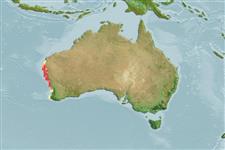>
Perciformes/Scorpaenoidei (Scorpionfishes) >
Scorpaenidae (Scorpionfishes or rockfishes) > Scorpaeninae
Etymology: Scorpaena: Latin, scorpaena = a kind of fish, 1706 (Ref. 45335); gasta: Name from an Anglo-Saxon word 'gast' meaning spirit or apparition, referring to te somewhat ghostly appearance of alcohol-preserved specimen..
More on authors: Motomura, Last & Yearsley.
Environment: milieu / climate zone / depth range / distribution range
Écologie
marin démersal; profondeur 3 - 17 m (Ref. 57437). Tropical
Eastern Indian Ocean: Western Australia.
Taille / Poids / Âge
Maturity: Lm ? range ? - ? cm
Max length : 8.4 cm SL mâle / non sexé; (Ref. 57437); 7.4 cm SL (female)
Description synthétique
Morphologie | Morphométrie
This species has the following set of characters: 15 pectoral-fin rays; 36-40 longitudinal scale rows; 13 or 14 scales below lateral line; 5 scale rows between last dorsal-fin spine base and lateral line; 0-2 exposed predorsal scale rows; 13 gill rakers; anteroventral surface of body and pectoral-fin base covered with well-exposed scales; no median ridge at the anterior surface of preocular spine; a distinct longitudinal ridge on the lateral surface of maxilla; no spines on lateral surface of lacrimal; anterior lacrimal spine simple; occipital pit extremely deep; relatively thick skin with numerous small sensory pores covering predorsal area from posterior edge of occipital pit to first dorsal-fin spine origin (most predorsal scales embedded in skin), and extending to just above or near first pored lateral-line scale; similar skin with pores between opercular spines and covering upper spine; head and trunk with numerous tentacles, supraocular tentacle longest, about equal to or 1.5 times orbit diameter; anteroventral surface of lower jaw with 1 or 2 pairs of slender tentacles in ventral view; relatively shorter second, third, and fourth dorsal-fin spines (11.4-15.3% of SL [mean 13.3%], 15.8-18.6% [17.4%], 17.9-19.0% [18.4%], respectively), length of third spine less than upper-jaw length; caudal-peduncle depth relatively shallow (10.5-11.7% of SL [11.2%]); soft-rayed portion of dorsal fin with variable, diagonal cluster of black spots; spinous portion of dorsal fin uniform yellowish to reddish with narrow, translucent, submarginal stripe (Ref. 57437).
Life cycle and mating behavior
Maturité | Reproduction | Frai | Œufs | Fécondité | Larves
Motomura, H., P.R. Last and G.K. Yearsley, 2006. New species of shallow water scorpionfish (Scorpaenidae: Scorpaena) from the Central Coast of Western Australia. Copeia 2006(3):360-369. (Ref. 57437)
Statut dans la liste rouge de l'IUCN (Ref. 130435)
Menace pour l'homme
Harmless
Utilisations par l'homme
Plus d'informations
PaysZones FAOÉcosystèmesOccurrencesIntroductionsStocksÉcologieRégime alimentaireÉléments du régime alimentaireConsommation alimentaireRation
Noms communsSynonymesMétabolismePrédateursÉcotoxicologieReproductionMaturitéFraiRassemblement de ponteFéconditéŒufsDéveloppement de l'œuf
Taille/ÂgeCroissanceLongueur-poidsLongueur-longueurFréquences de longueursMorphométrieMorphologieLarvesDynamique des populations larvairesRecrutementAbondanceBRUVS
RéférencesAquacultureProfil d'aquacultureSouchesGénétiqueElectrophoresesHéritabilitéPathologiesTraitementNutrientsMass conversion
CollaborateursImagesStamps, Coins Misc.SonsCiguateraVitesseType de nageSurface branchialeOtolithesCerveauxVision
Outils
Articles particuliers
Télécharger en XML
Sources Internet
Estimates based on models
Preferred temperature (Ref.
123201): 18 - 24.6, mean 19.9 °C (based on 99 cells).
Phylogenetic diversity index (Ref.
82804): PD
50 = 0.5000 [Uniqueness, from 0.5 = low to 2.0 = high].
Bayesian length-weight: a=0.01318 (0.00626 - 0.02776), b=3.03 (2.86 - 3.20), in cm total length, based on LWR estimates for this Genus-body shape (Ref.
93245).
Niveau trophique (Ref.
69278): 3.4 ±0.2 se; based on size and trophs of closest relatives
Résilience (Ref.
120179): Haut, temps minimum de doublement de population inférieur à 15 mois (Preliminary K or Fecundity.).
Fishing Vulnerability (Ref.
59153): Low vulnerability (10 of 100).
